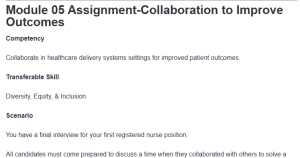Module 05 Assignment-Collaboration to Improve Outcomes
Describe the problem, including the healthcare delivery setting and impact on patient outcomes.
While working in a community health clinic as a nurse, I encountered a low treatment adherence rate of diabetic patients to treatment plans. This led to poor glycemic control and hospital admissions increased because of complications like diabetic ketoacidosis (DKA). The clinic serves a diverse population including Asian, African American, Hispanic, and immigrant communities. The high non-adherence rate resulted from several factors such as cultural misconceptions, language barriers, financial constraints, and less understanding of the disease.
Explain the collaborative solution, including the people involved and the improvement in patient outcomes.
An interprofessional collaboration helped address the high non-adherence rate. The clinic created a multidisciplinary team composed of physicians, nurses, dieticians, and dieticians. According to research, interprofessional teamwork decreases healthcare costs, promotes patient education, enhances preventative care, and results in better patient outcomes (Szafran et al., 2019). Through collaboration, most tasks were reallocated to team members enabling physicians to spend more time in other patient care activities.
As a nurse, my main responsibility was to enhance self-management patient education, increase care access, improve provider-patient relationships, support family physicians in patient care, and improve patient satisfaction (Szafran et al., 2019). The collaborative effort helped the clinic improve glycemic control among diabetic patients, reduced hospital admissions caused by uncontrolled diabetes, and higher patient satisfaction with their care.
Describe how diversity, equity, and inclusion were incorporated into the collaborative solution.
Diversity, equity, and inclusion were integrated into collaborative care in various ways. First, cultural competence training was conducted on all team members to help them comprehend and tackle cultural practices and beliefs effectively (Mullin et al., 2021). Secondly, educational sessions and materials were provided in various languages spoken by the population to maintain clear communication and treatment plans understanding. Thirdly, extensive community engagements were conducted to enhance program acceptance and uptake within various cultural groups. Lastly, equitable access to diabetes treatment resources like education, medications, and devices were made available regardless of insurance coverage or the socioeconomic status of patients (Mullin et al., 2021).
References
Mullin, A. E., Coe, I. R., Gooden, E. A., Tunde-Byass, M., & Wiley, R. E. (2021). Inclusion, diversity, equity, and accessibility: From organizational responsibility to leadership competency. Healthcare Management Forum, 34(6), 311–315. https://doi.org/10.1177/08404704211038232
Szafran, O., Kennett, S. L., Bell, N. R., & Torti, J. M. I. (2019). Interprofessional collaboration in diabetes care: perceptions of family physicians practicing in or not in a primary health care team. BMC Family Practice, 20(1). https://doi.org/10.1186/s12875-019-0932-9
ORDER A PLAGIARISM-FREE PAPER HERE
We’ll write everything from scratch
Question
Module 05 Assignment-Collaboration to Improve Outcomes
Competency
Collaborate in healthcare delivery systems settings for improved patient outcomes.
Transferable Skill
Diversity, Equity, & Inclusion.
Scenario
You have a final interview for your first registered nurse position.
All candidates must come prepared to discuss a time when they collaborated with others to solve a problem in a healthcare delivery setting. The collaborative solution must have improved patient outcomes and incorporate diversity, equity, and inclusion.
To prepare for the interview, you will create notes.
Directions

Module 05 Assignment-Collaboration to Improve Outcomes
Select an example that demonstrates collaboration with others to solve a problem in a healthcare delivery setting to improve patient outcomes. The collaborative solution must incorporate diversity, equity, and inclusion.
- Describe the problem, including the healthcare delivery setting and impact on patient outcomes.
- Explain the collaborative solution, including the people involved and the improvement in patient outcomes.
- Describe how diversity, equity, and inclusion were incorporated into the collaborative solution.

